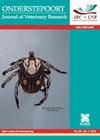A New Enzyme-linked Immunosorbent Assay for Serological Diagnosis of Seal Parapoxvirus Infection in Marine Mammals
IF 1.6
3区 农林科学
Q2 VETERINARY SCIENCES
引用次数: 1
Abstract
Abstract Introduction Seal parapoxvirus (SPPV) infection has been reported among pinnipeds in aquaria in Japan; however, its seroprevalence is unknown. Therefore, an enzyme-linked immunosorbent assay (ELISA) was developed for serological diagnosis of SPPV infection. Material and Methods The gene encoding the major envelope protein of SPPV was cloned into the eukaryotic expression vector pAcGFP1-N1, which encodes the green fluorescence protein (GFP), thereby producing a fusion protein (Env-GFP). Parental and cloned vector DNA was independently transfected into cultured seal cells for the expression of GFP and Env-GFP. The wells of an ELISA plate were coated with either GFP- or Env-GFP-transfected cell lysates. The light absorbance of each serum sample was adjusted by subtracting the absorbance of GFP-coated wells from that of Env-GFP-coated wells. Sera from two spotted seals (Phoca largha), six beluga whales (Delphinapterus leucas), three Pacific white-sided dolphins (Lagenorhynchus obliquidens), and ten bottlenose dolphins (Tursiops truncatus) from an aquarium in Japan were examined using the ELISA. Results Positive reactions were not observed, except in one preserved sample collected ten years ago from a naturally SPPV-infected spotted seal. Conclusion The established ELISA could be useful in screening marine mammal sera for anti-SPPV antibodies.一种新的用于海洋哺乳动物海豹副痘病毒感染血清学诊断的酶联免疫吸附试验
摘要日本水族馆报告了海豹副痘病毒感染病例;然而,其血清患病率尚不清楚。因此,建立了一种用于SPPV感染血清学诊断的酶联免疫吸附试验(ELISA)。材料与方法将SPPV主要包膜蛋白的编码基因克隆到编码绿色荧光蛋白(GFP)的真核表达载体pAcGFP1-N1中,产生融合蛋白(Env-GFP)。将亲本和克隆载体DNA分别转染到培养的海豹细胞中,分别表达GFP和Env-GFP。用转染GFP或env -GFP的细胞裂解物包被ELISA板孔。通过从env - gfp包被孔中减去gfp包被孔的吸光度来调整每个血清样品的吸光度。采用ELISA检测了日本某水族馆2只斑点海豹(Phoca largha)、6只白鲸(Delphinapterus leucas)、3只太平洋白边海豚(Lagenorhynchus obliquidens)和10只宽吻海豚(Tursiops truncatus)的血清。结果除10年前自然感染sppv的斑海豹标本外,未见阳性反应。结论建立的酶联免疫吸附试验可用于海洋哺乳动物血清抗sppv抗体的筛选。
本文章由计算机程序翻译,如有差异,请以英文原文为准。
求助全文
约1分钟内获得全文
求助全文
来源期刊
CiteScore
4.30
自引率
0.00%
发文量
13
审稿时长
16 weeks
期刊介绍:
The Onderstepoort Journal of Veterinary Research, is the official publication of the Onderstepoort Veterinary Institute. While it considers submissions from any geographic region, its focus is on Africa and the infectious and parasitic diseases and disease vectors that affect livestock and wildlife on the continent.

 求助内容:
求助内容: 应助结果提醒方式:
应助结果提醒方式:


